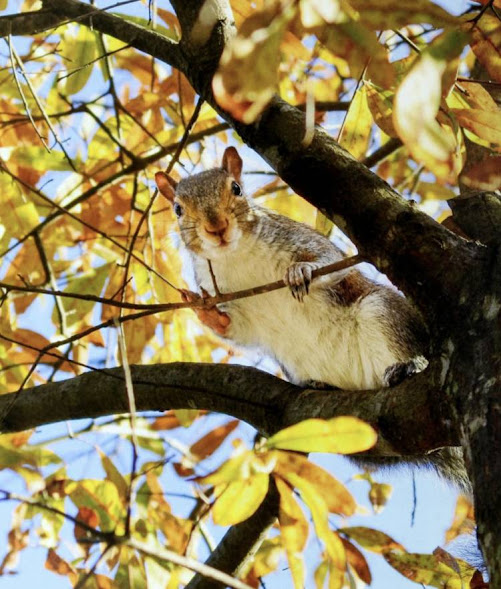Hail to the gray squirrel, the official state mammal of North Carolina since 1969. Bird feeder bullies are that they are.
Writing for Our State magazine, Susan Stafford Kelly said: “The last time I thought a squirrel was cute and furry was when I was a child.” One of her stuffed animal playmates was a squirrel.
State mammal is “an exalted position for a fairly lowly mammal,” Kelly said, “but the eastern gray squirrel (Sciurus carolinensis) is a prolific, adaptable species found in the eastern swamps to the western hardwood forests of North Carolina. In other words, it’s ubiquitous. Frisky. Playful.”
“Eastern gray squirrels
are crepuscular, more active during the early and late hours of the day,
avoiding the heat in the middle of a summer day,” Kelly said. “Gray squirrels
can live up to 15 years. My question is, if they’re already gray, how can I
tell if they’re old?”
“Their nests – masses of leaves and twigs in the forked branches of trees – are called ‘dreys,’ and the eastern gray squirrel is a scatter hoarder, meaning it hoards food in small caches for later. In this way, they’re similar to me with Halloween, Christmas and Easter candy,” Kelly wrote.
There is a threat looming on the horizon, however. A bill has been introduced in the North Carolina General Assembly that would end the gray squirrel’s rein as state mammal and insert the black bear in that position.
This could infuriate the descendants of Pee Wee who continue to inhabit the campus grounds of Duke University in Durham.
The Duke Today online
magazine commented: “Duke is internationally known for its teaching and
research, but all who work and study here know who really runs the place: the
gray squirrels.”
“From the university’s beginnings as Trinity College, faculty and staff have been amused by this scampering rodent, whose search for food seems to be equaled only by its need for mischief. Some, like Pee Wee the Squirrel, became campus legendary.”
“In the 1930s, Pee Wee was a frequent visitor to the offices of the Duke University Press,” where Exie Duncan, business manager, would snap pictures of Pee Wee having his mid-day snack. Her photographs began appearing in Duke publications.
Duke professors say the campus squirrels are synanthropes, which benefit and thrive from their interaction in human environments. The academicians say squirrels purposefully chose to colonize at Duke, so they could “entertain and remind” humans of nature.
One of Pee Wee’s kin was charged in 1966 with theft of snacks after being apprehended while raiding a dormitory vending machine.
The officer who nabbed the thief was campus security chief W. C. A. Bear. (You can read his formal report to Henry F. Bowers, director of university operations, at today.duke.edu.)
Tricia Tenpenny commented on the article. “I wondered why the candy machine in the basement of the old Union was always empty. Then one day I saw a squirrel crawl out of the machine with a Mounds bar in its mouth. Mystery solved.”
Until this day, the squirrels on the Duke campus are frequent photo subjects for the students who shoot pictures for the university yearbook.
As it now stands, Kentucky is the only other state that “pays tribute” to the gray squirrel – honoring it as Kentucky’s “state ‘wild game’ animal.”
That’s a curious choice
for Kentucky. Seemingly, Kentuckians excel in hunting squirrels, rather than
hares, opossum, turkeys, pheasants, deer, duck, geese and wild boars.




.jpg)

No comments:
Post a Comment